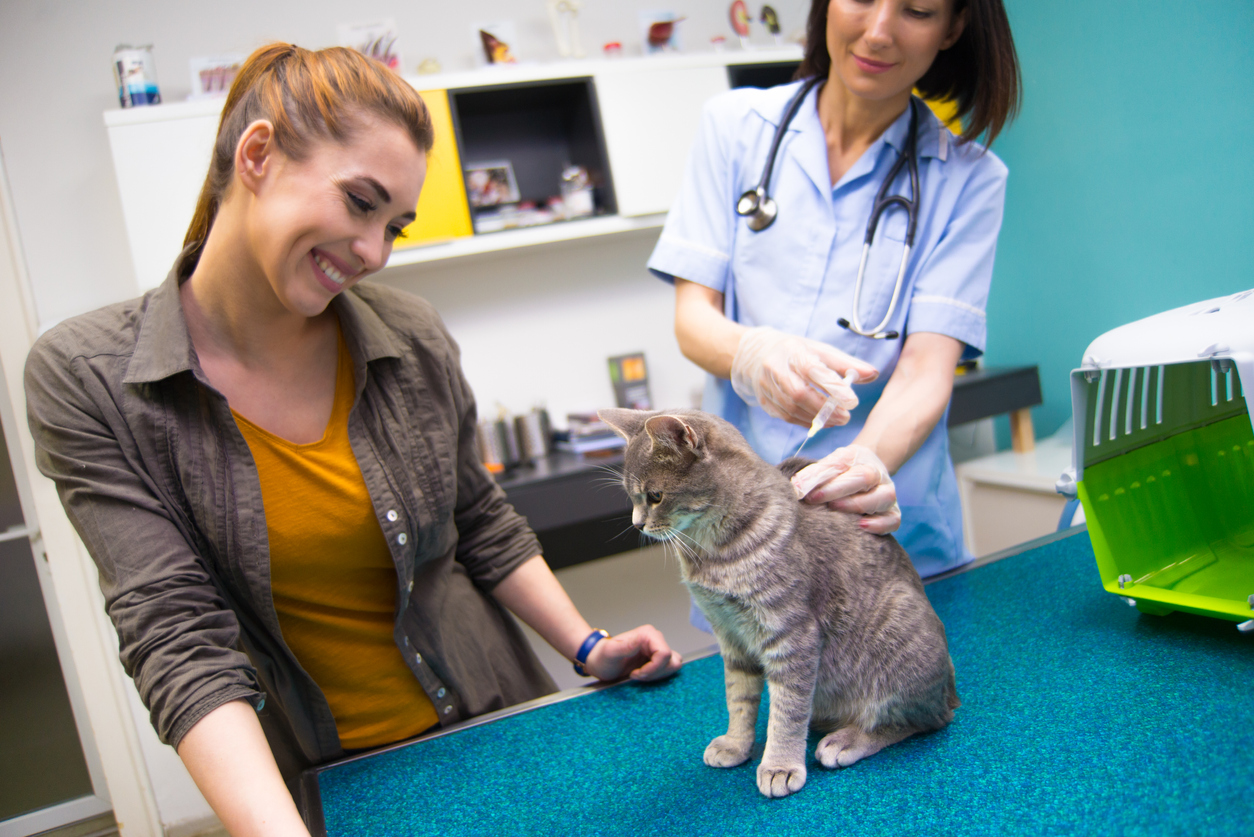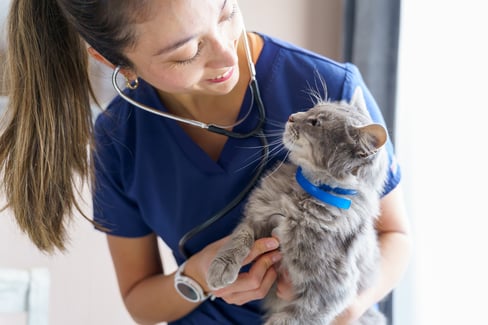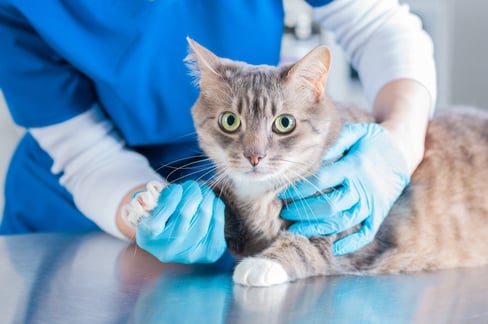Table of Contents
We often see diseases that we associate with humans happening in animals as well. Diabetes is one disease that can significantly affect overall cat health.
Just like humans, when cats have diabetes, it means that their pancreas doesn’t produce enough insulin, or that their body doesn’t adequately respond to the hormone. Insulin is a hormone that takes the energy that your cat gets from their food and distributes it to the cells around their body. This energy is in the form of glucose—a type of sugar.
When a cat has diabetes, their body can’t control the level of glucose in the blood. Untreated, this results in Hyperglycemia, which means there is too much glucose in the blood. Too much glucose in the blood can lead to a number of serious medical conditions, such as liver enlargement, nerve damage, lack of ability to heal wounds, increased chance of serious infection, and much more. It’s important to note that just because your cat has hyperglycemia, it doesn’t necessarily mean that they have diabetes. Hyperglycemia can be caused by trauma and stress as well, however, it usually resolves itself.
Hypoglycemia is another condition that’s worth mentioning, as it’s often talked about with feline diabetes. It’s the opposite of hyperglycemia—it’s when your cat has low blood sugar instead of high. This condition is a possible complication of insulin therapy or if your cat isn’t eating due to not feeling well. If your cat isn’t eating or has too much insulin in their blood, their body can’t get the energy it needs to function normally. As a result, your kitty can become lethargic, have a lack of coordination, have seizures, and even slip into a coma.
Just like humans, there have been two types of diabetes identified in cats: Type 1 diabetes and type 2 diabetes. Either type can lead to hyper or hypoglycemia in your cat, but it’s important to know the type of diabetes your cat has because each type has a unique treatment.
The types of diabetes that can affect your cat are outlined in the table below:
|
Type 1 Diabetes |
Type 2 Diabetes |
Type 3 Diabetes |
|
Your cat’s body isn’t producing enough insulin, so they need insulin injections to compensate. This type of diabetes is not common in cats; more often they are diagnosed with type 2 diabetes. |
Your cat’s body isn’t responding to insulin as it should. Your cat’s pancreas is producing insulin, but the cells in your cat’s body aren’t able to use the glucose that’s being provided to them, even though there’s plenty of it. |
Results from insulin resistance caused by other hormones due to pregnancy or hormone-secreting tumours. |
Type 2 diabetes is the most common type of diabetes diagnosed in cats, accounting for over 90% of cases. The prevalence of feline diabetes is low, with most studies reporting numbers from less than 1% of cats to just under 2%. However, there is evidence that susceptibility to diabetes in cats is increasing around the world.
Given the seriousness of feline diabetes, it’s extremely important that as a cat owner, you are aware of the symptoms of diabetes in cats so you can take action to get your kitty back to optimal health as soon as possible.
In this article, we explore the various symptoms of diabetes in cats, including early and end-stage symptoms, and how symptoms of diabetes in female cats differ from the symptoms of diabetes in male cats. In addition, we’ll explore treatment options for the disease.
Watching for Diabetes in Cats Symptoms
Diabetes is an extremely serious disease and if left untreated, will always result in your cat passing away. The good news is that with careful management, your cat can live a full and happy life. If you can spot the symptoms of diabetes in cats, you can get your feline friend help quickly, which will lessen the disease's impact on their body.
The longer your cat goes without treatment for diabetes, the greater the risk of additional complications, including enlarged liver and long-term or recurrent infections. This is where the risk of death becomes all but inevitable, as your kitty will eventually succumb to a secondary effect of uncontrolled diabetes.
Untreated or poorly managed feline diabetes can also result in a serious life-threatening condition called diabetic ketoacidosis. The signs of this condition include:
- Increased thirst and urination
- Lethargy
- Weakness
- Trouble breathing
If your kitty is experiencing any of the symptoms of diabetes in cats, you should get them to a veterinarian immediately for treatment.
Risk Factors
There are several risk factors for cats that could make them more susceptible to developing diabetes at some point in their lives. These risk factors include:
- Obesity. When your cat is obese, the tissues in their body often develop some insulin resistance, which may develop into full-on intolerance when presented with high glucose levels. While obese cat bodies may seem to compensate well for the insulin resistance in their tissues (various laboratory tests come back normal), one hypothesis suggests that the progression from insulin resistance to diabetes happens when the cat’s liver has finally become insulin resistant like the rest of the tissues in the cat’s body, so they start showing symptoms of diabetes in cats. A cat is often considered obese when they are over 3 lbs (1.3 kg) over their ideal weight, but you can always perform a body condition score assessment to see if your cat fits into the obese category.
- Age. Like humans, when cats age, their body starts slowing down. This means that the production of insulin or the ability of the tissues in their body to adequately respond to insulin may lessen. As a result, symptoms of diabetes in old cats are more likely to be observed.
- Physical inactivity. If your cat is lazier than they should be and doesn’t move around, they don’t burn off any extra calories from food and therefore increases their risk of diabetes. While the lack of physical activity itself doesn’t necessarily result in diabetes, the fact that your cat isn’t really using the energy it gets from their food means that it will get converted into fat, which has a cascading effect on cell insulin resistance and, finally the development of diabetes.
- Male cats. Many studies, including this one, have indicated that the risk factor for diabetes is higher in male cats. The increased risk seems to be genetic, although, like with any cat, male or female, careful management of food consumption and activity level can decrease the risk.
- Use of glucocorticoids (steroids). Some cats have conditions that need to be treated with immunosuppressive drugs, which are often glucocorticoids. These drugs can cause glucose intolerance in the cat’s body by antagonizing (causing a negative effect) the insulin on the tissues it targets, including muscle and adipose tissue.
By being aware of the risk factors that may lead your cat to develop diabetes, you can take better, more actionable steps to help prevent the development of this disease in your feline friend.
What Are Symptoms of Diabetes in Cats
While diabetes is a serious disease, it’s thankfully relatively easy to spot the potential symptoms of diabetes in cats. While not all the symptoms of diabetes in cats listed below may lead to a definitive diagnosis (some symptoms can be associated with other conditions as well), it’s a starting point for discussing your concerns with your veterinarian. Your vet will then perform a series of diagnostic tests to either confirm or deny the condition or determine whether another condition is causing the symptoms you’re seeing in your cat.
Early Symptoms of Diabetes in Cats
Recognizing potential early symptoms of diabetes in cats is extremely important for prompt diagnosis and treatment. The most common early symptoms of diabetes in cats that owners often recognize include:
- Increased urination: You can identify this symptom by carefully watching the number of pee spots in your cat’s litter box. Cats will often go in a different area (not on top of where they went earlier), so identifying how often your cat has urinated each time you clean their litter box should be straightforward. Litter boxes should be cleaned at least once daily, if not more frequently.
- Increase weight loss despite a healthy appetite: If you already have a thin cat, telltale signs of a cat losing weight include increasingly protruding hip bones and the ability to easily feel their ribs. In cats with a bit more chonk or heft, weight loss may not be as apparent. In both cases, however, cats that may have diabetes are often eating much more than they normally would, which should cause you to scratch your head as to why they are losing weight.
Symptoms of End-Stage Diabetes in Cats
For cats that are in the later or end stages of diabetes, the symptoms of diabetes in cats will include the ones listed above, but will also include more serious symptoms:
- Lethargy and extreme fatigue: While cats do sleep and lounge around, if they refuse food, show a lack of interest in activities that would usually excite them (catnip, toys, etc.), and overall look like they are a cat in pain or discomfort (see the feline grimace scale), then it’s time to bring them to the vet.
- Vomiting: not being able to keep down food or water is a telltale sign that something is amiss with your cat. Repeated vomiting also causes dehydration.
- Increased respiratory rate: The increased rate of breathing is usually due to diabetic ketoacidosis, which means the liver has become insulin-resistant. Increasing breathing may progress to slow, deep breaths over time.
- Unkempt coat and lack of grooming: When your cat has end-stage diabetes, it will likely not have the energy to keep up with their normal grooming. In addition, their coat will likely look unhealthy, which is a sign that they are sick.
- Cat’s breath and urine have a sweet smell: Because of the buildup of extra sugar in your cat’s body, their breath and/or urine may have a sweet smell.
- Plantigrade stance (walking on heels): Cats with advanced diabetes may develop cat limping as a result of issues with the tendons and muscles in their hind legs. Sometimes, the plantigrade stance is caused by diabetic neuropathy. The plantigrade stance may lessen with treatment.
Insulin Resistance in Male versus Female Cats
You might be wondering if the symptoms of diabetes in female cats differ from the symptoms of diabetes in male cats. Typically the symptoms of diabetes in cats, like increased urination and thirst, weight loss, and lethargy, will remain the same in cats regardless of their sex.
However, there are a few important pieces of information to keep in mind when it comes to insulin resistance in male versus female cats:
- Male-specific genetics can contribute to the development of diabetes
- Male cats have a higher predisposition to obesity compared to females
- Male cats have a greater tendency to show lower insulin sensitivity values when they are lean, which gets worse with weight gain
- Overweight and obese male cats tend to have higher insulin concentrations in the blood compared to females
- Male cats are overall heavier than females, which is a contributing factor to the development of diabetes
- Neutered male cats over 10 years of age and weighing more than 15 pounds pose the greatest risk of developing diabetes.
Symptoms of Diabetes in Old Cats
While the symptoms of diabetes in old cats are no different from the symptoms of diabetes in cats of younger ages, The prevalence of diabetes is thought to be much higher in older cats. This could be due to a number of factors, like the fact that their little cat bodies are slowing down due to the normal aging process, but the simple fact that the more time goes on, the more they are exposed to potential causes of all types of diseases, including diabetes.
Also, it’s a simple fact that the older a cat gets, the more their metabolism slows down, which can contribute to weight gain, especially if their diet isn’t adjusted. Even when a cat is only moderately overweight, it can significantly increase their risk of various serious diseases and conditions, including diabetes.
Consider that if your cat only weighs 8 lbs to begin with, and they gain 1 lbs, that’s a 12.5% increase in body weight—which is quite significant. If your cat gains 2 lbs, that’s a quarter, or 25%, of the total body weight that they’ve just added. For comparison, this weight gain would be the same as a person weighing 200 lbs gaining about 50 lbs!
As you can imagine, just like people, an increase in body weight that’s this significant can lead to serious problems for your kitty. And just like people, when a cat is older, the effects of serious weight gain are harder on their body than if they were younger. It’s also more difficult for your senior cat to lose weight because of a slower metabolism and not being able to move around as much compared to when they were younger, making it harder to shed excess pounds.
For mobility issues associated with age and joints, consider introducing a cat mobility supplement like TRI-ACTA H.A.
TRI-ACTA H.A. for Pets
Our maximum strength formula is optimally designed to accelerate the formation of cartilage, minimize inflammation, expedite the healing process, and improve joint conditions.

How to Treat the Symptoms for Diabetes in Cats
Treating the symptoms of diabetes in cats first requires the condition to be diagnosed. Your vet may perform a few tests at first to rule out other conditions exhibiting similar symptoms to diabetes in your cat, such as hyperthyroidism, kidney disease, pancreatitis, or even a urinary tract infection.
Once these other diseases and conditions have been ruled out, Your veterinarian will need to determine if the glucose levels in your cat’s blood are consistently elevated with repeated laboratory tests. This is because your cat may display symptoms of high blood glucose due to stress (and it’s stressful to go to the vet!) which can lead to a false diagnosis of diabetes if only one blood test is done.
The laboratory test that’s usually done to determine whether a cat has diabetes or not is called a serum fructosamine test. This test measures the average blood glucose in a cat over a period of 7–14 days.
After your veterinarian has, without a doubt, determined that your cat has diabetes, it’s time to create a treatment plan. The main goals for treating feline diabetes are:
- Restoring normal blood glucose levels
- Stopping or controlling weight loss
- Minimizing increased thirst and urination
- Avoiding instances of hypoglycemia (low blood sugar) as a result of treatment
To accomplish these treatment goals, there are several approaches that must be considered. These approaches are outlined in the table below:
|
Feline Diabetes Treatment |
Reason |
|
If the cat is taking corticosteroids, work on getting the cat to stop taking this medication. |
Corticosteroids can predispose cats to developing diabetes. Stopping these drugs may cause the condition to resolve on its own. |
|
Losing weight |
Obese cats have a more difficult time controlling their blood sugar due to their cells developing insulin resistance. Getting their weight down to a normal number may resolve diabetes in some cats. Slow, controlled weight loss under the close monitoring of a vet is important to gain control over blood glucose levels. |
|
Insulin therapy |
Insulin injections may be necessary for cats with diabetes and is often the go-to treatment. There are several different types of insulin available that vary in cost, duration of action, and concentration, so discussing the pros and cons of the different types of insulin with your vet is necessary. Usually, insulin injections are given under the skin every 12 hours. Due to the small needle size, it’s actually relatively easy for cat owners to administer the injection themselves, and cats usually tolerate it quite well. |
|
Dietary therapy |
A diet low in carbohydrates can help reduce blood sugar regulation in diabetic cats. Prescription food options are available in both wet and dry cat food. Getting the timing of meal times right may be tricky, and it often depends on the cat and the insulin used. Free feeding may be an acceptable option for cats who prefer to graze alongside an insulin injection that is longer-lasting. |
In addition to the therapies listed above, close monitoring of your cat’s condition is extremely important. This should be done by both yourself and your veterinarian. Regular monitoring helps determine the optimal insulin dose for your cat and avoid potential complications, such as hypoglycemia from too much insulin. Taking note of your cat’s weight, water intake, and appetite are important parts of continuous monitoring.
Owners of cats with diabetes will also need to check their kitty’s blood sugar using a glucose curve technique. In a glucose curve, the cat’s blood sugar is checked right before an insulin injection is administered and then for 1–4 hours throughout the day. From that data, it’s easy to determine whether your kitty’s blood glucose is consistently in an acceptable range or if it’s spiking or dropping.
Doing a glucose curve is necessary within the first few weeks after a cat is diagnosed with diabetes to get the dose of insulin right. Once a cat becomes stable, the glucose curve should be performed every 3–4 months to ensure your cat stays on the right track.
Summary
If your cat is exhibiting diabetes in cats symptoms, the best course of action is to take them to the vet right away to get a definitive diagnosis. Some important takeaways from this article to keep in mind if you’re noticing signs of diabetes in cats symptoms include:
- Early symptoms of diabetes in cats include increased urination and thirst.
- Male cats are more predisposed to diabetes than female cats due to their genetics, physiology, and predisposition to weight gain.
- Symptoms of diabetes in old cats are the same as their younger counterparts, but older cats are more predisposed to developing diabetes.
- Treatment for diabetes in cats symptoms includes insulin therapy, weight reduction, and dietary changes.
Protecting your cat’s health is of the utmost importance. In addition to diabetes, cats often experience joint problems. To prevent your cat from developing common joint problems like cat arthritis, it’s important to give them cat supplements like TRI-ACTA. Formulated with 100% natural ingredients, TRI-ACTA contains the essentials to protect your cat’s joint health, like glucosamine, chondroitin, and Methylsulfonylmethane (MSM, a natural anti-inflammatory).
TRI-ACTA for Pets
A proactive approach for developing and younger adult pets to maintain optimal joint health mobility, minimize inflammation and fend off age-related ailments.

Purchase TRI-ACTA online today or learn where to buy in a store near you.
Newsletter Signup
Subscribe to our newsletter to receive the latest news and exclusive offers.
.jpg?height=2000&name=Cliick_Integricare-DISPLAY-REVISEDV2%20(1).jpg)
Proactive & Therapeutic Joint Supplements
When given daily, Integricare joint supplements recover bone and joint injuries faster and help prevent mobility injuries from happening in the first place.











